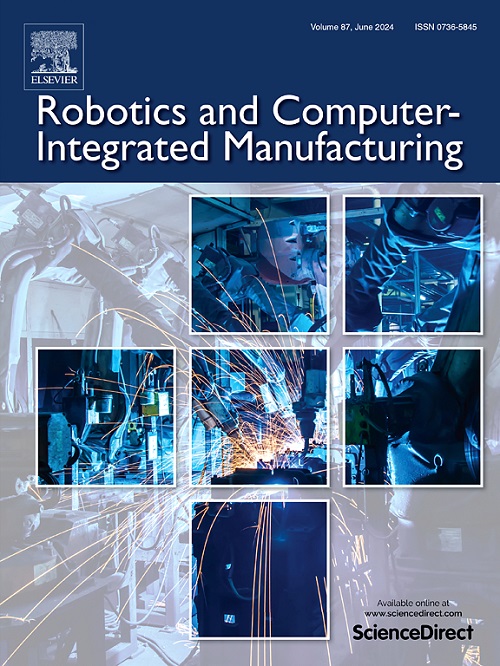一种基于视觉的工业机器人变位姿自标定方法
IF 11.4
1区 计算机科学
Q1 COMPUTER SCIENCE, INTERDISCIPLINARY APPLICATIONS
引用次数: 0
摘要
在用于机器人自标定的各种几何约束中,同时约束机器人末端执行器位置和姿态的位姿约束是最全面、最有效的约束。然而,由于难以控制机器人精确满足姿态约束,设计了一种基于视觉的机器人姿态测量系统,该系统主要由固定在调节台上的两个单色摄像机和安装在机器人末端执行器上的姿态目标模块组成。当在固定位置用两台单色相机测量两个或多个机器人的姿态时,建立可变姿态约束。基于指数积(POE)公式,建立了一种基于变位姿约束的工业机器人自标定模型,该模型将机器人位姿误差表示在其刀架中,并将位置误差与姿态测量误差解耦。因此,所提出的自校准模型比传统的机器人位姿误差在基架中表示、位置误差与姿态测量误差耦合的自校准模型更准确、鲁棒。仿真和实验验证了所提出的自标定方法的有效性。在Aubo i5机器人上的实验结果表明,标定后的平均位置误差从2.47 mm减小到0.77 mm,平均方位误差从0.016 rad减小到0.0039 rad。本文章由计算机程序翻译,如有差异,请以英文原文为准。
A vision-based self-calibration method for industrial robots using variable pose constraints
Among various geometrical constraints employed for robot self-calibration, the pose constraint by simultaneously restricting the position and orientation of the robot end-effector is the most comprehensive and effective constraint. However, as it is difficult to control the robot to precisely satisfy the pose constraints, a vision-based robot pose measurement system is designed, which mainly consists of two monochrome cameras fixed onto an adjustment stage and a pose target module mounted on the robot end-effector. Variable pose constraints are established when two or more robot poses are measured with two monochrome cameras at a fixed location. Based on the product-of-exponential (POE) formula, a new self-calibration model is formulated for industrial robots using variable pose constraint in which the robot pose errors are expressed in its tool frame and the position errors are decoupled from the orientation measurement errors. Therefore, the proposed self-calibration model is more accurate and robust than the conventional calibration model, in which the robot pose errors are expressed in its base frame and the position errors are coupled with the orientation measurement errors. Both simulations and experiments are conducted to validate the effectiveness of the proposed self-calibration method. Experimental results on the Aubo i5 robot demonstrate that after calibration, the average position error is reduced from 2.47 mm to 0.77 mm, and the average orientation error is reduced from 0.016 rad to 0.0039 rad.
求助全文
通过发布文献求助,成功后即可免费获取论文全文。
去求助
来源期刊
CiteScore
24.10
自引率
13.50%
发文量
160
审稿时长
50 days
期刊介绍:
The journal, Robotics and Computer-Integrated Manufacturing, focuses on sharing research applications that contribute to the development of new or enhanced robotics, manufacturing technologies, and innovative manufacturing strategies that are relevant to industry. Papers that combine theory and experimental validation are preferred, while review papers on current robotics and manufacturing issues are also considered. However, papers on traditional machining processes, modeling and simulation, supply chain management, and resource optimization are generally not within the scope of the journal, as there are more appropriate journals for these topics. Similarly, papers that are overly theoretical or mathematical will be directed to other suitable journals. The journal welcomes original papers in areas such as industrial robotics, human-robot collaboration in manufacturing, cloud-based manufacturing, cyber-physical production systems, big data analytics in manufacturing, smart mechatronics, machine learning, adaptive and sustainable manufacturing, and other fields involving unique manufacturing technologies.

 求助内容:
求助内容: 应助结果提醒方式:
应助结果提醒方式:


